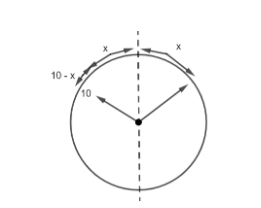
At what time between 10 O’clock and 11 O’ clock are the two hands of the clock symmetric with respect to the vertical line (give the answer to the nearest second)?
(a) 10h 9m 13s
(b) 10h 9m 14s
(c) 10h 9m 22s
(d) 10h 9m 50s
Answer
493.5k+ views
Hint: We have to find the time at which two hands (minute hand and hour hand) becomes symmetric. We will consider that after x minute, it becomes symmetric. Then we will find the relation between the speed of the minute hand and the hour hand to compare how much distance they cover. We will get that their speed ratio is 1:12. Once we find out the value of x, we will add 10 hours to it and get our answer.
Complete step-by-step answer:
We are asked about the time between 10’O clock and 11’O clock when two hands are symmetric with respect to the vertical line.
First of all, we will understand what the vertical line is. When we draw a line passing through 6 and 12 in the clock, that line is referred to as a vertical line.
Let us start by assuming that at x minutes after 10 o’clock, the two hands become symmetric with respect to the vertical line.

Before we move further, we have to find the ratio between the minute hand and the hour hand. We know in that in 60 minute, minute: hand covers \[{{360}^{\circ }}.\]
So, in one minute, minute hand covers, \[\dfrac{{{360}^{\circ }}}{60}={{6}^{\circ }}.\]
While in 60 minute, hour hand covers \[{{30}^{\circ }}.\]
And in one minute, hour hand covers \[\dfrac{{{30}^{\circ }}}{60}={{0.5}^{\circ }}.\]
So, we will get the ratio of hour hand speed to the minute hand speed as \[\dfrac{0.5}{6}=\dfrac{1}{12}.\]
So, we get the speed of the hour hand and minute hand as 1:12.
This means when our minute moves x minute distance, then the hour hand moves \[\dfrac{x}{12}\] minute distance.
Therefore, we get,
\[\dfrac{x}{12}=10-x\]
Now, we will solve for x. Therefore, we get,
\[\Rightarrow \dfrac{x}{12}+x=10\]
\[\Rightarrow \dfrac{13x}{12}=10\]
\[\Rightarrow x=\dfrac{10\times 12}{13}\]
\[\Rightarrow x=\dfrac{120}{13}\]
x = 9 minute 13.8 seconds.
Hence, our required time in the nearest seconds is 9 minutes 14 seconds.
So, at 10h 9m 14s, two hands will become symmetric.
So, the correct answer is “Option C”.
Note: The key point the students need to know is the relation of how the hour hand moves with respect to the minute hand. The conversion of the minute to minute and seconds is a crucial step. While solving for x, we get \[x=\dfrac{10\times 12}{13}=\dfrac{120}{13}\] which when divided further, we get, \[x=9\dfrac{3}{13}.\] So, here 9 is the perfect minute and we will convert \[\dfrac{3}{13}\] into seconds, so as 1 minute = 60 seconds. So, \[\dfrac{3}{13}\min =\dfrac{3\times 60}{13}=\dfrac{180}{13}\sec .\] Now, we will get 13.8 seconds. So, we finally get \[x=\dfrac{120}{13}\] as equal to 9 minutes and 13.8 seconds.
Complete step-by-step answer:
We are asked about the time between 10’O clock and 11’O clock when two hands are symmetric with respect to the vertical line.
First of all, we will understand what the vertical line is. When we draw a line passing through 6 and 12 in the clock, that line is referred to as a vertical line.
Let us start by assuming that at x minutes after 10 o’clock, the two hands become symmetric with respect to the vertical line.

Before we move further, we have to find the ratio between the minute hand and the hour hand. We know in that in 60 minute, minute: hand covers \[{{360}^{\circ }}.\]
So, in one minute, minute hand covers, \[\dfrac{{{360}^{\circ }}}{60}={{6}^{\circ }}.\]
While in 60 minute, hour hand covers \[{{30}^{\circ }}.\]
And in one minute, hour hand covers \[\dfrac{{{30}^{\circ }}}{60}={{0.5}^{\circ }}.\]
So, we will get the ratio of hour hand speed to the minute hand speed as \[\dfrac{0.5}{6}=\dfrac{1}{12}.\]
So, we get the speed of the hour hand and minute hand as 1:12.
This means when our minute moves x minute distance, then the hour hand moves \[\dfrac{x}{12}\] minute distance.
Therefore, we get,
\[\dfrac{x}{12}=10-x\]
Now, we will solve for x. Therefore, we get,
\[\Rightarrow \dfrac{x}{12}+x=10\]
\[\Rightarrow \dfrac{13x}{12}=10\]
\[\Rightarrow x=\dfrac{10\times 12}{13}\]
\[\Rightarrow x=\dfrac{120}{13}\]
x = 9 minute 13.8 seconds.
Hence, our required time in the nearest seconds is 9 minutes 14 seconds.
So, at 10h 9m 14s, two hands will become symmetric.
So, the correct answer is “Option C”.
Note: The key point the students need to know is the relation of how the hour hand moves with respect to the minute hand. The conversion of the minute to minute and seconds is a crucial step. While solving for x, we get \[x=\dfrac{10\times 12}{13}=\dfrac{120}{13}\] which when divided further, we get, \[x=9\dfrac{3}{13}.\] So, here 9 is the perfect minute and we will convert \[\dfrac{3}{13}\] into seconds, so as 1 minute = 60 seconds. So, \[\dfrac{3}{13}\min =\dfrac{3\times 60}{13}=\dfrac{180}{13}\sec .\] Now, we will get 13.8 seconds. So, we finally get \[x=\dfrac{120}{13}\] as equal to 9 minutes and 13.8 seconds.
Recently Updated Pages
The correct geometry and hybridization for XeF4 are class 11 chemistry CBSE

Water softening by Clarks process uses ACalcium bicarbonate class 11 chemistry CBSE

With reference to graphite and diamond which of the class 11 chemistry CBSE

A certain household has consumed 250 units of energy class 11 physics CBSE

The lightest metal known is A beryllium B lithium C class 11 chemistry CBSE

What is the formula mass of the iodine molecule class 11 chemistry CBSE

Trending doubts
Explain the system of Dual Government class 8 social science CBSE

What is Kayal in Geography class 8 social science CBSE

Who is the author of Kadambari AKalidas B Panini C class 8 social science CBSE

In Indian rupees 1 trillion is equal to how many c class 8 maths CBSE

Advantages and disadvantages of science

Write the smallest number divisible by both 306 and class 8 maths CBSE





